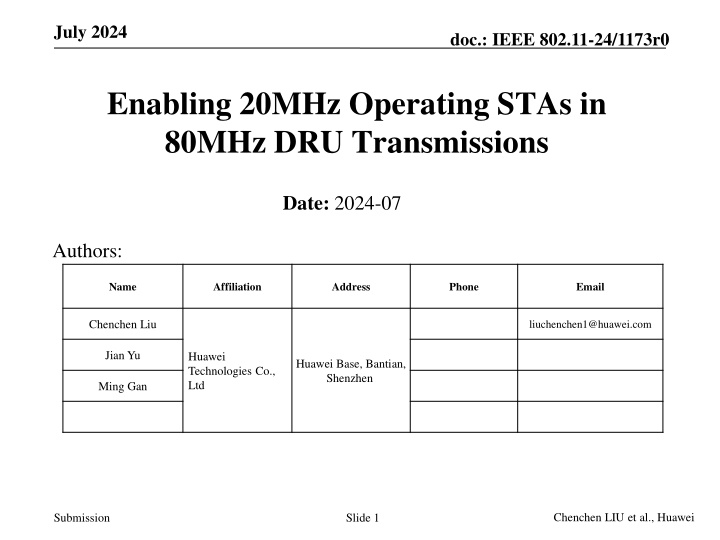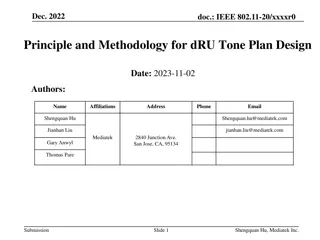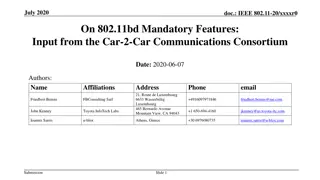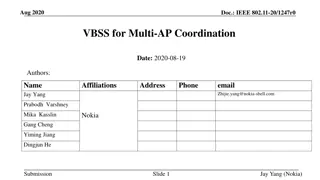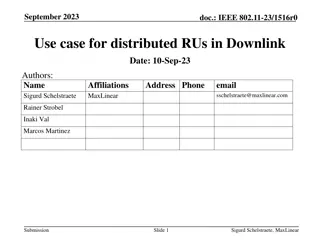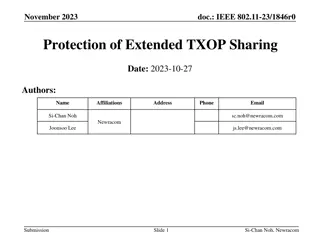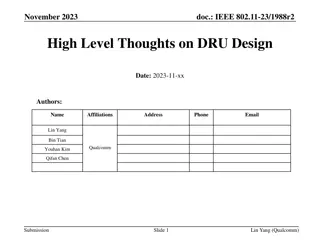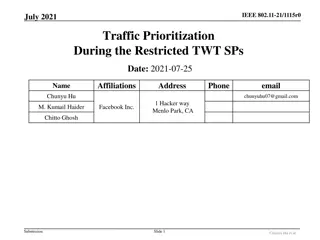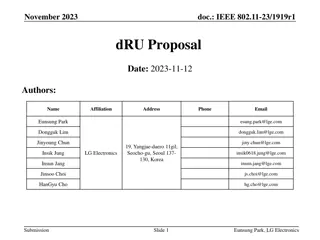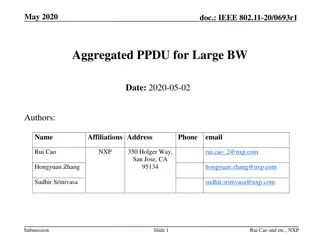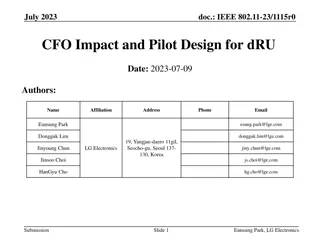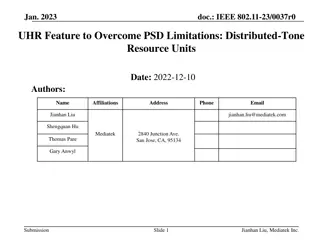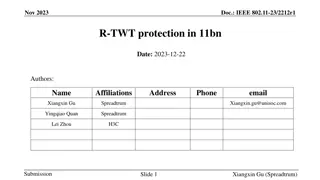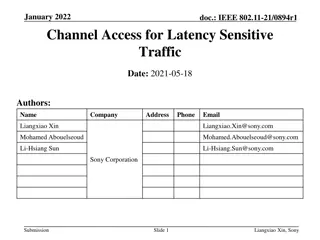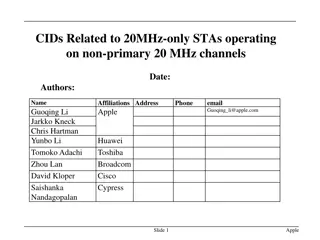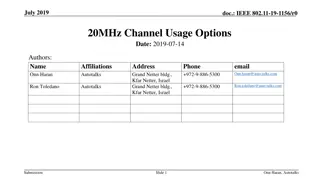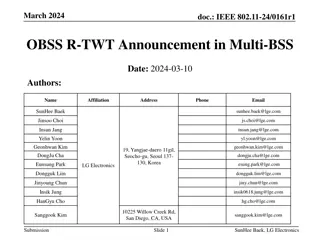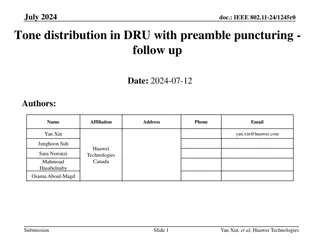Enabling 20MHz STAs in 80MHz DRU Transmissions
The document discusses the introduction, current solutions, and a proposed method for enabling 20MHz operating STAs to participate in 80MHz DRU transmissions. It addresses the challenges faced due to the uniform distribution of DRUs and proposes a subdivision approach to allow 20MHz STAs to efficiently utilize the bandwidth. The benefits of the proposal include inclusive bandwidth support, optimized power boosting, and simplified signaling protocols, enhancing flexibility and efficiency in wireless communication systems.
Download Presentation

Please find below an Image/Link to download the presentation.
The content on the website is provided AS IS for your information and personal use only. It may not be sold, licensed, or shared on other websites without obtaining consent from the author.If you encounter any issues during the download, it is possible that the publisher has removed the file from their server.
You are allowed to download the files provided on this website for personal or commercial use, subject to the condition that they are used lawfully. All files are the property of their respective owners.
The content on the website is provided AS IS for your information and personal use only. It may not be sold, licensed, or shared on other websites without obtaining consent from the author.
E N D
Presentation Transcript
July 2024 doc.: IEEE 802.11-24/1173r0 Enabling 20MHz Operating STAs in 80MHz DRU Transmissions Date: 2024-07 Authors: Name Affiliation Address Phone Email Chenchen Liu liuchenchen1@huawei.com Jian Yu Huawei Technologies Co., Ltd Huawei Base, Bantian, Shenzhen Ming Gan Chenchen LIU et al., Huawei Submission Slide 1
July 2024 doc.: IEEE 802.11-24/1173r0 Introduction Objective of DRU: DRUs are designed to overcome PSD limitations in uplink OFDMA transmissions by distributing tones across the entire bandwidth. DRU Sizes in 80MHz Bandwidth: The permissible DRU configurations include 484-tone, 242-tone, 106-tone, and 52- tone setups, according to the current discussion[1]-[4]. Uniform Distribution: All DRUs, irrespective of size, are dispersed nearly uniformly across the entire bandwidth, enhancing power boosting gain. Limitation for 20MHz STAs: Due to this uniform distribution, 20MHz operating STAs currently cannot participate in 80MHz DRU transmissions, restricting their usability in broader bandwidth scenarios. Chenchen LIU et al., Huawei Submission Slide 2
July 2024 doc.: IEEE 802.11-24/1173r0 Current Solutions and Their Limitations Current Solution: Utilizing 20+20+40MHz distribution modes within the 80MHz Physical Protocol Data Unit (PPDU) to facilitate different STA bandwidth capabilities. Inherent Limitations: This method leads to reduced power boosting gain and lowers frequency spectrum efficiency due to the fragmentation of the spectrum. Our Contribution: We propose a new method to enable 20MHz operating STAs to participate in 80MHz DRU transmissions without the drawbacks of current solutions. Chenchen LIU et al., Huawei Submission Slide 3
July 2024 doc.: IEEE 802.11-24/1173r0 Enabling 20MHz STAs in 80MHz DRU Transmissions Subdivision of 106-tone DRU: Utilizing the nearly uniform distribution characteristic of DRUs, we propose dividing a 106-tone DRU within an 80MHz spreading bandwidth into four 26-tone segments. Each of these segments will occupy a discrete 20MHz subchannel, hereafter referred to as a 26-tone sub-DRU. ... ... ... ... ... Tone indices of 106-tone DRU 26-tone Sub-DRU1 26-tone Sub-DRU2 26-tone Sub-DRU3 26-tone Sub-DRU4 Allocation to 20MHz STAs: These 26-tone sub-DRUs can be efficiently allocated to 20MHz operating STAs using the existing Resource Unit (RU) allocation methods, ensuring compatibility and ease of integration. Scalability to Other DRU Sizes: This subdivision approach is not limited to 106-tone DRUs; it can also be applied to other DRU sizes, enhancing the flexibility and utility of the network to support various STA bandwidth requirements. Chenchen LIU et al., Huawei Submission Slide 4
July 2024 doc.: IEEE 802.11-24/1173r0 Benefits of the Proposal Inclusive Bandwidth Support: Our proposal enables STAs of different operating bandwidths to participate in 80MHz DRU transmissions. This inclusivity allows for greater flexibility and utilization of frequency resources. Optimized Power Boosting: By allowing all STAs, regardless of their bandwidth, to access optimized DRUs, the proposal ensures optimal power boosting gains across all DRU sizes and operating bandwidths. Simplified Signaling: The reuse of existing RU allocation methods simplifies signaling protocols, reducing the complexity and overhead associated with the sub-DRU Chenchen LIU et al., Huawei Submission Slide 5
July 2024 doc.: IEEE 802.11-24/1173r0 Summary We introduced an approach to subdivide 106-tone DRUs into four 26-tone sub-DRUs within an 80MHz bandwidth, enabling 20MHz operating STAs to participate in 80MHz DRU transmissions. Our proposal ensures that STAs of varying bandwidths can access 80MHz transmissions, maximizes power boosting gains, and simplifies signaling by reusing existing RU allocation protocols. We suggest to adopt this sub-DRU concept to UHR to achieve greater efficiency, inclusivity, and simplicity, making high-bandwidth DRU transmissions accessible to a wider range of devices. Chenchen LIU et al., Huawei Submission Slide 6
July 2024 doc.: IEEE 802.11-24/1173r0 References [1] 11-23-1988-02-00bn-considerations-on-dru-design-and-application [2] 11-23-2021-00-00bn-principle-and-methodology-for-dru-tone-plan-design [3] 11-24-0468-02-00bn-DRU-Tone-Plan-for-11bn [4] 11-24-0799-00-00bn-DRU-Tone-Plan-from-the-perspective-of-PAPR [5] IEEE P802.11be /D5.0 Chenchen LIU et al., Huawei Submission Slide 7
July 2024 doc.: IEEE 802.11-24/1173r0 SP1 Do you agree to include the following into the 11bn SFD? 11bn supports support 20MHz operating devices for 80MHz distributed bandwidth DRU transmission in UHR. Chenchen LIU et al., Huawei Submission Slide 8
July 2024 doc.: IEEE 802.11-24/1173r0 SP2 Do you agree to include the following into the 11bn SFD? 11bn adopting this 26-tone sub-DRU structure(sub-DRU within 20MHz BW) to support 20MHz operating devices for 80MHz distributed BW DRU transmission in UHR. Detailed tone indices for each 26-tone sub-DRU are TBD Chenchen LIU et al., Huawei Submission Slide 9
